L.O.V.E + P.E.A.C.E & OTHER DRUGS
Written by Priyanka Paliwal & Richa Jain
Graphics by Nimisha More
Share this article
“The soldier above all others prays for peace, for it is the soldier who must suffer
and bear the deepest wounds and scars of war.” – Douglas MacArthur
We too are soldiers going through the war of everyday lives, of deadlines and pending bills, of stress and anxiety, of missed trains and missed calls, lost opportunities and dreadful anticipation, of procrastination and expectations. That’s why we need love and peace in this world, for ourselves, for those around us; to stop being hurt and hurting others, to stop fighting the war.
But you ask, what is its relevance in physiotherapy?
Let me answer this with a question. Whenever our patient comes to us in pain due to an ankle sprain, hamstring strain, or some other soft tissue injury, what is our first instinct?
Yup, you got that right. To ice it!
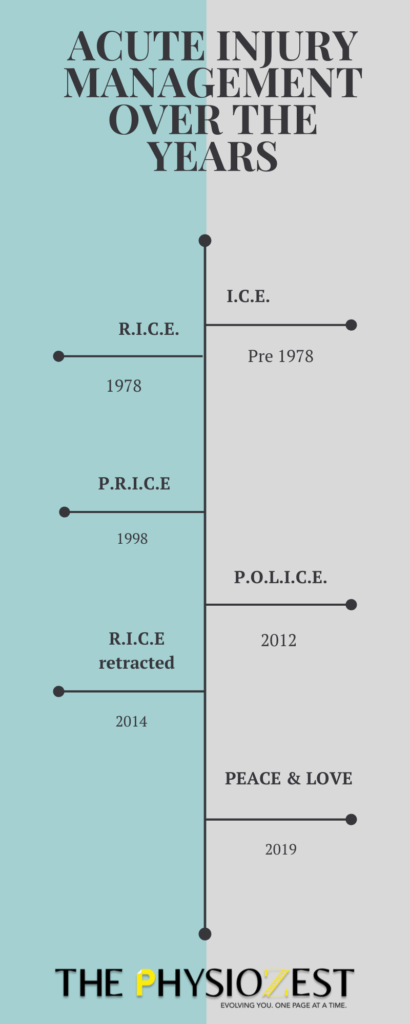
It’s not just ice but the entire RICE approach to a soft tissue injury. This was followed by PRICE.
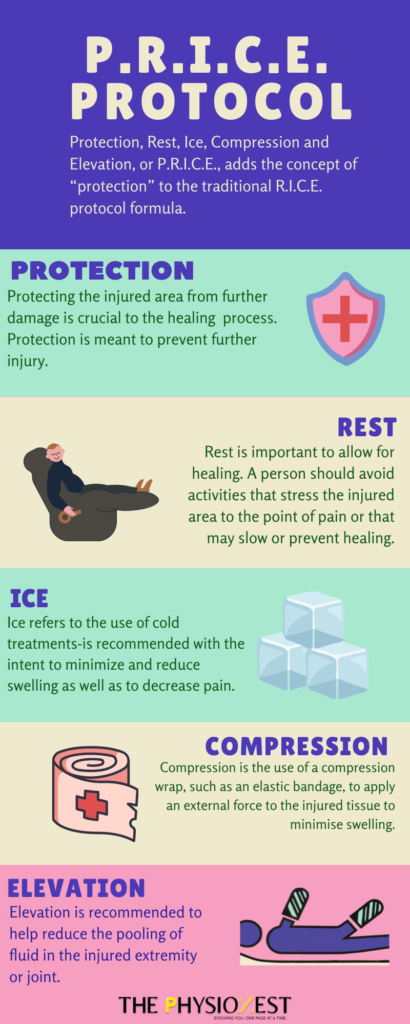
Later it was realized that rest for more than 48 hours was detrimental as it could cause joint stiffness, muscle weakness and prolonged rest can alter the biomechanics of the neighboring joints. ¹
This leads to the development of the POLICE approach.
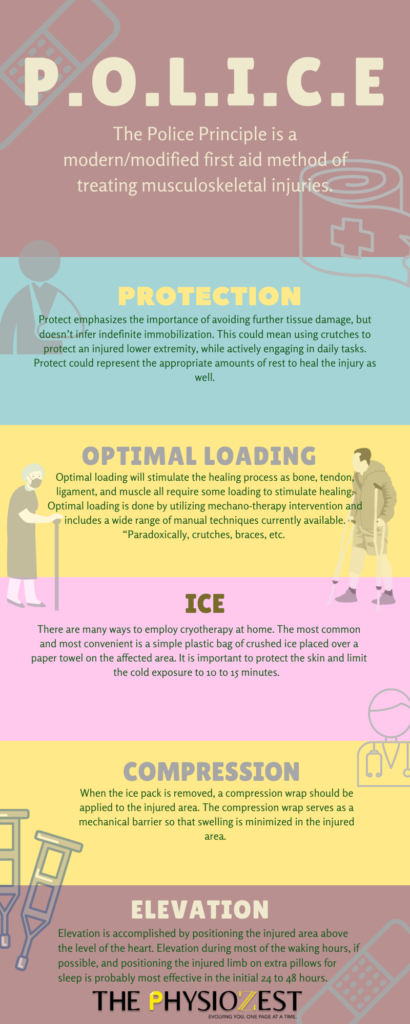
But is ice really that necessary and useful, that we claim it to be?
For this, we first need to understand the process of healing.
Inflammation is good for the body!
Inflammation is the natural response of the body to injury. Inflammation is like an immune response as explained by Dr. Mirkin in 2015. After any soft tissue injury, inflammatory cells migrate to the site of injury to initiate the healing process. Macrophages release a hormone Insulin-like Growth Factor (IGF-1) at the site of injury assists the muscle and other soft tissues in healing.
As we all know the application of ice causes vasoconstriction which will prevent the inflammatory cells from reaching the site of injury and thereby delay healing. On similar lines, anything that will reduce inflammation will also delay healing. NSAIDs, cortisone-type drugs will result in delayed healing.
Thus, the new concept of PEACE & LOVE was introduced.
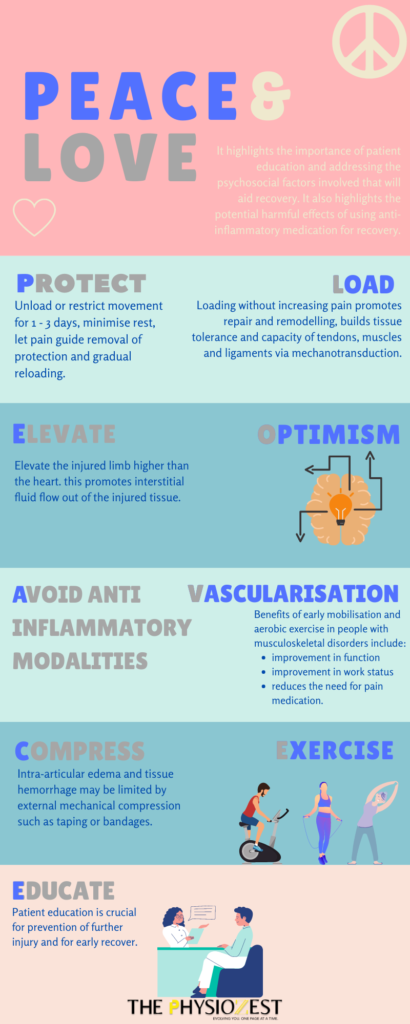
So how do we use this PEACE & LOVE method in case of an injury?
“Immediately after injury, give your body some peace.”
PROTECT– Protection is important to prevent injury from worsening. In case of an injury to your leg, you can use crutches, cane, or hiking poles to limit or avoid weight-bearing. Or you can partially immobilize it by using a sling, splint, or brace. The notion is to unload or restrict movement for 1-3 days. It’s not really a good idea to prolong rest as it can compromise tissue strength and quality.
ELEVATE– Elevation is done by positioning the injured part above heart level. Keeping 2 pillows below that leg will help reduce the pooling of fluid in the injured extremity or joint. It is important to control swelling to reduce pain and limit the loss of range of motion.
AVOID– Avoid anti-inflammatory modalities. Our first instinct when we see redness or swelling is to either ice it or take NSAIDs or other medications to reduce it. We must understand that inflammation is an integral part of the repair and avoiding it can result in delayed healing.
COMPRESSION– Using elastic bandages can help reduce excessive swelling and prevent tissue hemorrhage. Make sure it’s not too tight that it obstructs blood flow.
EDUCATE– As physiotherapists, it is our responsibility to educate patients on the benefits of an active approach to recovery.
For an individual, being well-informed about the condition and load management can help avoid overtreatment that can increase the chances of getting invasive procedures.
“After a few days, it’s time to give the injured tissues LOVE.”
LOAD– You can resume normal activities as soon as your symptoms allow. Optimal loading without aggravating pain promotes healing.
OPTIMISM– Instead of saying “Oh, I can’t do this”, try saying “Let me see what I CAN do.” Optimism is associated with a better prognosis and it improves the likelihood of optimal recovery.
VASCULARISATION– Start doing pain-free cardiovascular exercises a few days after injury to increase blood flow to the injured structures and boost motivation.
EXERCISE– Begin with rehabilitation exercises as they can help restore mobility, strength, and proprioception early after injury. Pain should be avoided to ensure optimal repair and should be used as a cue for exercise progression.
Having said that, excessive inflammation is harmful as it can exert undue pressure on tissues, restrict movement and muscle function, and can increase pain. In such cases, ice can be used to restrict excess inflammation rather than to prevent it completely.
Why do we need peace and love literally also?
In the current pandemic, we all have realized the importance of having peace of mind. Asking for peace is one of the most quoted lines in our daily life. We need to give ourselves time to introspect, time to heal and most importantly we must learn to forgive ourselves.
We all want to be loved, don’t we? But before that why not learn to love ourselves before expecting someone else to love us first. Let’s embrace our flaws, our faults, our disabilities, our shortcomings. C’mon let’s be honest, no one’s perfect.
Being perfect is like a straight line and we all know what that means on an ECG monitor!
References
1.https://www.sportsandspinal.net.au/early-injury-management-peace-love-not-harm/
2. https://www.drmirkin.com/fitness/why-ice-delays-recovery.html
3. For peace and love: https://bjsm.bmj.com/content/bjsports/54/2/72.full.pdf
4. https://www.helpinghandshealth.co.uk/blog/what-to-do-in-the-first-2-days-of-a-muscle-tear
5. https://bestbody.com.au/how-to-apply-peace-and-love-on-soft-tissue-injuries/
Contributors:

PRIYANKA PALIWAL
Research & Content Writing Team

RICHA JAIN
Research & Content Writing Team
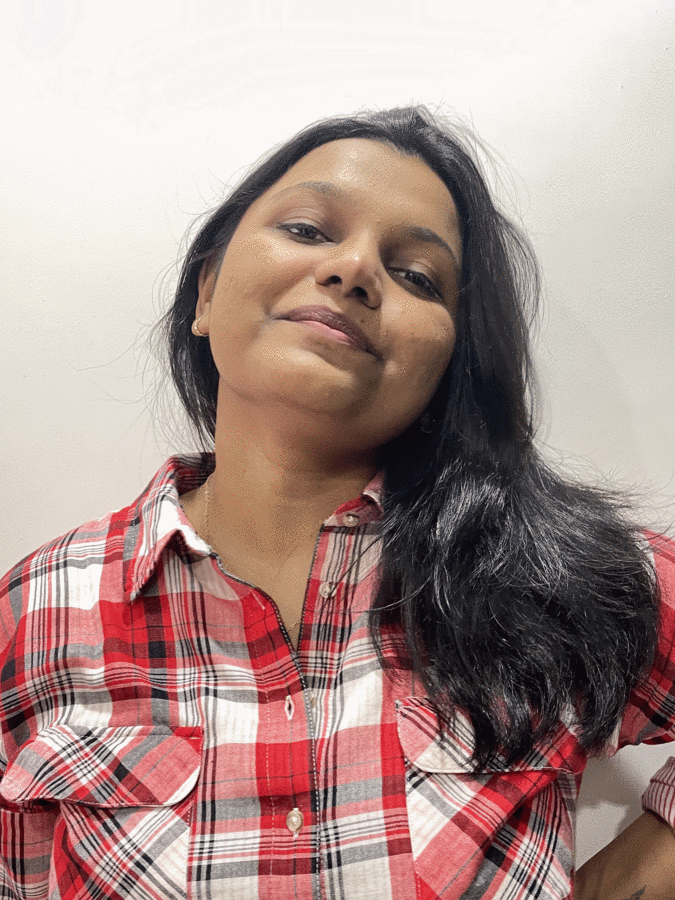
NIMISHA MORE
Multimedia Team
